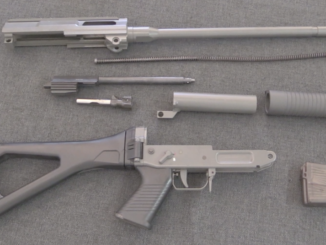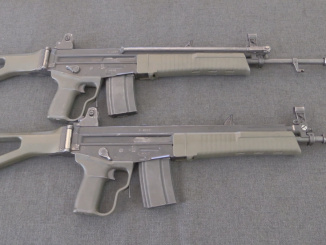The N33 is one of a series of Swiss prototype semiautomatic rifles developed between WWI and WWII (the “33” refers to 1933). This particular design is interesting because it fires from an open bolt, a feature generally seen on light machine guns. An open bolt rifle typically is more difficult to shoot accurately because of the time between trigger pull and firing as the bolt travels forward to load a cartridge before firing it.
The N33 was made in several calibers, but never went into any sort of significant production.




Beautiful piece, Zh29 sort of but turned around and slimmed down. Excellently made, really nice to look at.
Zh29’ish in my humble opinion, but it’s definitely a beauty, all round.
Open bolt aside etc’ish…
Ian, you should pay a visit to the Schützenmuseum in Bern – there’s a load of prototype semiauto rifles on one of the walls. I may be able to get you privileged access (friend of a friend, if he’s not pushing up the dasies).
Ian, I thought the Swiss constitution did not allow Swiss made weapons to be sold outside of Switzerland. Would those rifles have to be made outside of the country? Say, by Manhurin or J P Saur&sons.
“I thought the Swiss constitution did not allow Swiss made weapons to be sold outside of Switzerland.”
From which year? Does it apply to ANY weapon? I know that 1930s, 1940s and 1950s exported various weapons:
SIG P210 automatic pistol (9×19, exported to Denmark)
SIG MKMO sub-machine gun (exported to Finland)
SIG MP-48 sub-machine gun (9×19, exported to Chile)
SIG SG 510 battle rifle (7.62×51 NATO, exported to Chile)
Solothurn S-18/1000 (20×138, exported to Italy)
Also the M 1893/94 and M1908 Mondragón rifles exported to Mexico and Germany
I don’t think it’s true with all the Swiss surplus firearms available.
The 7,65 mm cartridge could be the 7.65×53mm Argentine cartridge
https://en.wikipedia.org/wiki/7.65%C3%9753mm_Argentine
used by several countries a good choice if you want export the rifle.
I thought I heard Ian say7.5 but thought I saw 7.65 on the magazine. Glad to know I’m not the only one
ARGH! I definitely want to see this get developed into a squad-automatic-weapon. It might even surpass the Furrer LMG-25!!!
“An open bolt rifle typically is more difficult to shoot accurately because of the time between trigger pull and firing as the bolt travels forward to load a cartridge before firing it.”
BAR 1918 is example of open-bolt automatic rifle (which would be in modern parlance called battle rifle). Is BAR 1918 in semi-auto mode significantly less accurate that say M1 Garand?
Based on my experience firing GPMGs (M60, MAG, PK, Bren) and open bolt SMGs (Thompson M1A1, M3. Ppsh, Sten, Uzi, Sterling, Ingrahm M10) the answer is no, not really. Open bolts do however have an entirely different “feel” to them when firing. One has to learn what amounts to two different ways to shoot. That certainly can be done, I’ve seen MAG gunners knock over individuals at a good 250 meters with a single aimed shot.
I agree with Marcus that the “7.65” is almost certainly 7.65 x 53 Mauser, because the next nearest thing to it is the 7.65 x 64 Brenneke, which would require a much longer magazine (being 1mm longer than the 7.62 x 63mm aka .30-06).
The “L” might in fact stand for “Latin” America, as the 7.65 was at that time the most common military rifle caliber on the South American continent. (Post-WW2, it would largely be superseded by the .30-06 due to MAP sales of surplus Garand rifles and Browning MGs.)
As for the 7.9 x 57 marked “J”, this almost certainly indicates that the rile has the original 1888 .318″ “J” bore specification rather than the later .323″ “S” bore. Again, this was probably intended as an export item, as the “J” bore was the most common in rifles sold overseas by DWM prior to 1914. Hence local ammunition manufacture would be in .318″. The fact that this rifle could fire that ammunition accurately would have been a a strong selling point.
As for how it would be exported, at the time SiG had several “quiet” arrangements with concerns in other countries, notably in Germany. Most likely, the rifles would have been marked as being manufactured by DWM, although the actual production line would no doubt have remained in Neuhausen.
cheers
eon
Could be that “L” stands for “Lateinisch”. Or “Leicht” (light) due to the smaller cartridge, which is almost certainly 7.65 Mauser.
However, I’d be very much doubtful that “J” is indicative of a “J”-bore 7.92mm, since this had been obsolete for 30+ years by that point and would thus present an obvious safety issue with the commonly-available JS ammunition. 7.92mm J is also round-nose.
Could be that it’s simply an “I” for “Infanterie” (some Germanic fonts have the I and J extremely similar, and distinguished by the length (or absence) of the top bar and/or the hook – one of my daughter’s reading books is like that. The font used on the side of the receiver has a barless-J for an I. I’ve been reading old Swiss books about their experiences in WW1 recently, so I’ve had to teach myself to read Gothic script. There are pairs of extremely similar letters to someone raised on Latin scripts: A/U; G/S; t/k, long-s/f, u/x, I/J).
“Gothic script”
Did you know:
https://de.wikipedia.org/wiki/Schwabacher
Schwabacher was once default German font, but 3 January 1941 it was declared to be Schwabacher Judenlettern (Schwabacher Jews letters) by Martin Bormann and hence was banned. It was replaced by Deutsche Normalschrift.
MERRY CHRISTMAS IAN ,
HEALTH ,LOVE , HAPPINESS AND MANY MORE INFORMATIVE POSTS .
It has nice, clean lines and looks like it should have handled well. I wonder if they considered redesigning the sear mechanism and making it into a more conventional closed bolt design.